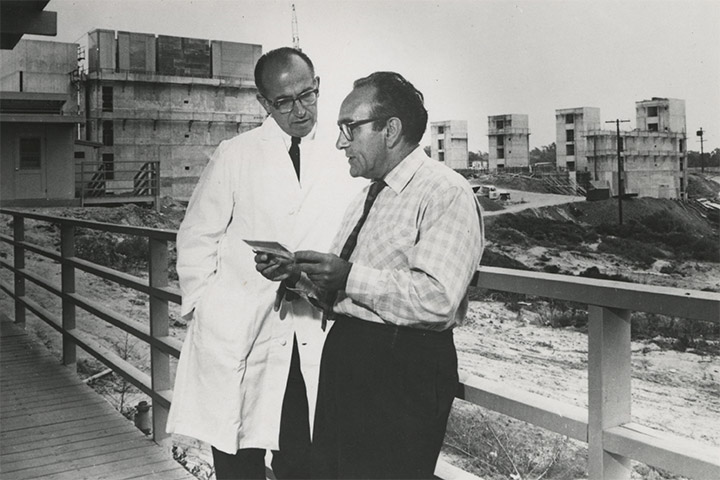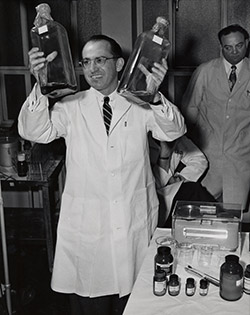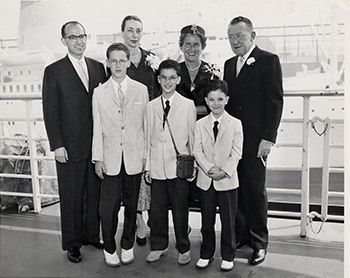UC San Diego Library Receives Personal Papers of Jonas Salk
Published Date
By:
- Dolores Davies
Share This:
Article Content

Jonas Salk (left) with Jacob Bronowski in front of the Salk Institute, during construction.
The University of California, San Diego Library has become the official repository for the papers of Jonas Salk, noted physician, virologist, and humanitarian, best known for his development of the world’s first successful vaccine for the prevention of polio.
The papers—which constitute almost 600 linear feet (or nearly 900 boxes)—were recently donated to the Library’s Mandeville Special Collections by Salk’s sons, Peter, Darrell and Jonathan, all of whom, like their father, trained as physicians and are involved in medical and scientific activities.
While recognized world-wide for his significant contributions, Jonas Salk is particularly noted locally for his founding of the Salk Institute for Biological Studies adjacent to UC San Diego and the impact this had on the city’s metamorphosis into a major center for biomedical and scientific research and discovery. The Institute will celebrate the Jonas Salk Centenary in the fall of 2014 and, as part of this notable milestone, the Library will hold a major exhibition of the Salk Papers and collaborate with the Institute on other celebratory events.

Jonas Salk holding bottles of his vaccine. The University of Pittsburgh Virus Research Laboratory, 1957.
“It is a great honor for the Library to be the official repository for Jonas Salk’s papers,” said Brian E. C. Schottlaender, The Audrey Geisel University Librarian at UC San Diego. “The UC San Diego Library’s Mandeville Special Collections houses the papers of some of the world’s most prominent and accomplished scientists, including Francis Crick, Stanley Miller, and Leo Szilard, as well as Nobel Laureates Harold Urey, Hannes Alfven, and Maria Goeppert Mayer. The papers of Jonas Salk are an excellent complement to these materials.”
The Salk papers constitute an exhaustive source of documentation on Salk’s professional and scientific activities. The papers cover the period from the mid-1940s to his death in 1995; best documented are activities largely related to the development of the Salk polio vaccine in the mid-1950s to the early 1960s and the founding of the Salk Institute. The papers cover general correspondence, files relating to polio, his writings, photographs, artifacts—including two dictating machines—personal writings, and various research materials.
The collection includes correspondence with a number of prominent scientists and others, including Basil O’Connor and officers of the National Foundation for Infantile Paralysis/March of Dimes; immunologists Thomas Francis and Albert Sabin; physicist and biologist Leo Szilard; mathematician and philosopher Jacob Bronowski; architect Louis Kahn and other important figures in the worlds of art, science, education, public administration, and humanitarianism.
Salk came to La Jolla following a career in clinical medicine and virology research. After obtaining his M.D. degree at the New York University School of Medicine in 1939, he served as a staff physician at Mount Sinai Hospital in New York City. He then joined his mentor, Dr. Thomas Francis, as a research fellow at the University of Michigan. There he worked to develop an influenza vaccine at the behest of the U.S. Army. In 1947, he was appointed director of the Virus Research Laboratory at the University of Pittsburgh School of Medicine, where he began to put together the techniques that would lead to his polio vaccine.

Jonas Salk (far left) with family members and Basil O’Connor), 1957.
Salk’s research caught the attention of O’Connor, then president of the National Foundation for Infantile Paralysis, and the organization decided to fund his efforts to develop a killed virus vaccine against the most frightening scourge of the time—paralytic poliomyelitis. Given the fear and anxiety that polio caused during the first half of the century, the vaccine’s success in 1955 made Salk an international hero, and he spent the late 1960s refining the vaccine and establishing the scientific principles behind it.
Salk chose San Diego as the site for what was to become the Salk Institute for Biological Studies after a year touring the country for the right location. In June, 1960, through a referendum, the citizens of San Diego overwhelmingly voted to make a gift of 27 pueblo lots in the La Jolla area, just west of the new University of California San Diego campus, for Salk’s dream. The Institute began operation in temporary quarters in 1963, and permanent buildings designed by architect Kahn were completed in 1967. The complex soon gained international fame for its extremely modern and austere design, which now enjoys a cult following among architecture and design buffs. Salk served as the Institute’s director until 1975.
Share This:
You May Also Like
Engineers Take a Closer Look at How a Plant Virus Primes the Immune System to Fight Cancer
Technology & EngineeringStay in the Know
Keep up with all the latest from UC San Diego. Subscribe to the newsletter today.



